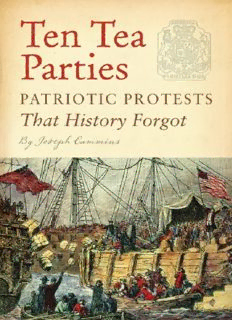
Ten Tea Parties: Patriotic Protests That History Forgot PDF
Preview Ten Tea Parties: Patriotic Protests That History Forgot
Copyright © 2012 by Joseph Cummins All rights reserved. No part of this book may be reproduced in any form without written permission from the publisher. Library of Congress Cataloging in Publication Number: 2011933426 eISBN: 978-1-59474562-1 Typeset in Bembo and Old Claude Designed by Doogie Horner Production management by John J. McGurk Cover and interior illustrations courtesy the Bridgeman Art Library On the cover: The Boston Tea Party, 16th December 1773. Engraving. Private collection/The Bridgeman Art Library. Quirk Books 215 Church Street Philadelphia, PA 19106 quirkbooks.com v3.1 Cover Title Page Copyright INTRODUCTION T C EA AND THE OMPANY T B T P HE OSTON EA ARTY T P T P HE HILADELPHIA EA ARTY T C T P HE HARLESTON EA ARTIES T N Y T P HE EW ORK EA ARTY T C T P HE HESTERTOWN EA ARTY T Y T P HE ORK EA ARTY T A T P HE NNAPOLIS EA ARTY T E W T P HE DENTON AND ILMINGTON EA ARTIES T G T P HE REENWICH EA ARTY E PILOGUE APPENDIX: EVEN MORE TEA PARTIES BIBLIOGRAPHY PHOTO CREDITS ACKNOWLEDGMENTS Introduction What discontents, what dire events, From trifling things proceed? A little Tea, thrown in the Sea Has thousands caused to bleed. —Anonymous New Hampshire poet t was more than just a little tea, of course. The tea that dozens of I patriots dumped into Boston Harbor on the chilly evening of December 16, 1773, amounted to more than 92,000 pounds. Tall piles of the stuff floated like huge haystacks in the dim moonlight of the bay. And in the days that followed, many British observers wondered if the residents of Boston had gone insane. After all, weren’t these the same colonists who consumed between 1,200,000 and 2,000,000 pounds of tea a year? One-third of America’s three million inhabitants drank tea twice a day. Yet now this hearty and warming stimulant was being tossed to the seagulls like so much wharf trash? What happened after the Boston Tea Party was even more remarkable: Other colonists, men and women widely separated from Bostonians in culture and outlook, rallied behind their Massachusetts brethren. Up and down the eastern seaboard, from York, Maine, to Charleston, South Carolina, colonists dumped, burned, and boycotted tea. They threatened those who delivered its leaves—be they ships’ captains or humble peddlers—with everything from tarring and feathering to financial ruin. They scorned neighbors who drank tea and concocted an entirely fictitious sickness narrative around the beverage; they claimed tea stunted growth, turned men into pygmies, and transformed women into, as one patriot writer put it, “God knows what.” They claimed that tea was stomped into chests by Chinese men with dirty feet, that it was infested with bugs. This book tells the largely forgotten stories of ten colonial-era tea parties—protests in which tea was boycotted, destroyed, or worse. In these tales, Americans banded together to wage an economic war. And make no mistake—despite the tea party’s more theatrical and carnivalesque trappings, this was war, with clear threats of violence directed at all those who dared to disagree with the patriots. When tea merchant Anthony Stewart was forced to set his ship Peggy Stewart ablaze in Annapolis, the mob deliberately engineered the conflagration to occur in front of the house where his wife, Peggy (the ship’s namesake), was giving birth to their child. Tea parties were not pretty, but then neither was the revolution. Taken together, these ten examples form an untold narrative of American independence, a narrative that contains the DNA of future American protest movements. Over the course of the nation’s history, when times are tough and the chips are down, Americans have put aside their geographical and cultural differences to band together as a nation, as one. That had never happened before these early tea parties. In them, colonists overcame what historian T. H. Breen calls “local jealousies and mutual ignorance, profound fear and clashing identities” to find “a common political vision”—what one tea-burning group of citizens called “a general American union.” These ten tea parties are among the most important and influential milestones in America’s growth and development—and it’s a shame that so many are largely forgotten. Whenever the nation faces a challenge— whenever times require us to cooperate and serve together—the tea parties serve as an illuminating and inspiring example of all that Americans acting together can achieve.
Description: